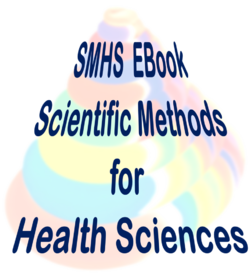Difference between revisions of "Scientific Methods for Health Sciences"
| Line 108: | Line 108: | ||
* SOCR Home page: http://www.socr.umich.edu | * SOCR Home page: http://www.socr.umich.edu | ||
| − | {{translate|pageName=http://wiki.socr. | + | {{translate|pageName=http://wiki.socr.umich.edu/index.php?title=Scientific_Methods_for_Health_Sciences}} |
Revision as of 11:08, 26 June 2014
Contents
- 1 SOCR Wiki: Scientific Methods for Health Sciences
- 2 Preface
- 3 Chapter I: Fundamentals
- 3.1 Exploratory Data Analysis, Plots and Charts
- 3.2 Ubiquitous variation
- 3.3 Parametric inference
- 3.4 Probability Theory
- 3.5 Odds Ratio/Relative Risk
- 3.6 Probability Distributions
- 3.7 Resampling/Simulation
- 3.8 Design of Experiments
- 3.9 Intro to Epidemiology
- 3.10 Experiments vs. Observational studies
- 3.11 Estimation
- 3.12 Hypothesis
- 3.13 Data management
- 3.14 Statistical Power, sample-size, effect-size, sensitivity, specificity
- 3.15 Bias/Precision
- 3.16 Association vs. Causality
- 3.17 Rate-of-change
- 3.18 Clinical vs. Stat significance
- 3.19 Statistical Independence Bayesian Rule
- 4 Chapter II: Applied Inference
- 4.1 Epidemiology
- 4.2 Correlation/SLR (ρ and slope inference, 1-2 samples)
- 4.3 ROC Curve
- 4.4 ANOVA
- 4.5 Non-parametric inference
- 4.6 Cronbach's α
- 4.7 Measurement Reliability/Validity
- 4.8 Survival Analysis
- 4.9 Decision theory
- 4.10 CLT/LLNs – limiting results and misconceptions
- 4.11 Association Tests
- 4.12 Bayesian Inference
- 4.13 PCA/ICA/Factor Analysis
- 4.14 Point/Interval Estimation (CI) – MoM, MLE
- 4.15 Instrument performance Evaluation
- 4.16 Study/Research Critiques
- 4.17 Common mistakes and misconceptions in using probability and statistics, identifying potential assumption violations, and avoiding them
- 5 Chapter III: Linear Modeling
- 5.1 MLR Regression
- 5.2 GLM
- 5.3 ANOVA
- 5.4 ANCOVA
- 5.5 MANOVA
- 5.6 MANCOVA
- 5.7 Repeated measures ANOVA
- 5.8 (Partial) Correlation
- 5.9 Time series analysis
- 5.10 Fixed, randomized and mixed models
- 5.11 Hierarchical Linear Models
- 5.12 Multi-Model Inference
- 5.13 Mixture modeling
- 5.14 Surveys
- 5.15 Longitudinal data
- 5.16 Generalized Estimating Equations (GEE) models
- 5.17 Model Fitting and Model Quality (KS-test)
- 6 Chapter IV: Special Topics
- 6.1 Scientific Visualization
- 6.2 PCOR/CER methods Heterogeneity of Treatment Effects
- 6.3 Big-Data/Big-Science
- 6.4 Missing data
- 6.5 Genotype-Environment-Phenotype associations
- 6.6 Medical imaging
- 6.7 Data Networks
- 6.8 Adaptive Clinical Trials
- 6.9 Databases/registries
- 6.10 Meta-analyses
- 6.11 Causality/Causal Inference, SEM
- 6.12 Classification methods
- 6.13 Time-series analysis
- 6.14 Scientific Validation
- 6.15 Geographic Information Systems (GIS)
- 6.16 Rasch measurement model/analysis
- 6.17 MCMC sampling for Bayesian inference
- 6.18 Network Analysis
SOCR Wiki: Scientific Methods for Health Sciences
Electronic book (EBook) on Scientific Methods for Health Sciences (coming up ...)
Preface
This is an electronic Internet-based Scientific Methods for Health Sciences (SMHS) EBook. The materials, tools and demonstrations presented in this EBook may be helpful to learners, instructors and scientists involved in biomedical, healthcare, Big Data, and informatics studies. The EBook is initially developed by the University of MIchigan Statistics Online Computational Resource (SOCR). However, many students, faculty, educators and member of the community participate, and others are encouraged to take part, in expanding, improving and validating the content of these learning materials.
There are 4 novel features of this specific EBook. It is community-built, completely open-access (in terms of use and contributions), blends information technology, scientific techniques and modern pedagogical concepts, and is multilingual.
Format
Follow the instructions in this page to expand, revise or improve the materials in this EBook.
Learning and Instructional Usage
This section describes the means of traversing, searching, discovering and utilizing the SMHS EBook resources in both formal and informal learning setting.
Copyrights
The SMHS EBook is a freely and openly accessible electronic book developed by SOCR and the general community.
Chapter I: Fundamentals
Exploratory Data Analysis, Plots and Charts
Ubiquitous variation
Parametric inference
Probability Theory
Odds Ratio/Relative Risk
Probability Distributions
Resampling/Simulation
Design of Experiments
Intro to Epidemiology
Experiments vs. Observational studies
Estimation
Hypothesis
Data management
Statistical Power, sample-size, effect-size, sensitivity, specificity
Bias/Precision
Association vs. Causality
Rate-of-change
Clinical vs. Stat significance
Statistical Independence Bayesian Rule
Chapter II: Applied Inference
Epidemiology
Correlation/SLR (ρ and slope inference, 1-2 samples)
ROC Curve
ANOVA
Non-parametric inference
Cronbach's α
Measurement Reliability/Validity
Survival Analysis
Decision theory
CLT/LLNs – limiting results and misconceptions
Association Tests
Bayesian Inference
PCA/ICA/Factor Analysis
Point/Interval Estimation (CI) – MoM, MLE
Instrument performance Evaluation
Study/Research Critiques
Common mistakes and misconceptions in using probability and statistics, identifying potential assumption violations, and avoiding them
Chapter III: Linear Modeling
MLR Regression
GLM
ANOVA
ANCOVA
MANOVA
MANCOVA
Repeated measures ANOVA
(Partial) Correlation
Time series analysis
Fixed, randomized and mixed models
Hierarchical Linear Models
Multi-Model Inference
Mixture modeling
Surveys
Longitudinal data
Generalized Estimating Equations (GEE) models
Model Fitting and Model Quality (KS-test)
Chapter IV: Special Topics
Scientific Visualization
PCOR/CER methods Heterogeneity of Treatment Effects
Big-Data/Big-Science
Missing data
Genotype-Environment-Phenotype associations
Medical imaging
Data Networks
Adaptive Clinical Trials
Databases/registries
Meta-analyses
Causality/Causal Inference, SEM
Classification methods
Time-series analysis
Scientific Validation
Geographic Information Systems (GIS)
Rasch measurement model/analysis
MCMC sampling for Bayesian inference
Network Analysis
- SOCR Home page: http://www.socr.umich.edu
Translate this page:
